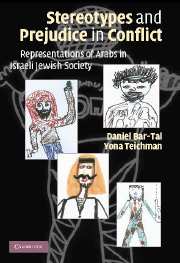Book contents
- Frontmatter
- Contents
- List of Tables
- List of Drawings
- List of Figures
- Preface
- Stereotypes and Prejudice in Conflict
- Introduction
- 1 The Psychological Basis of Intergroup Relations
- 2 Psychological Intergroup Repertoire in Intractable Conflicts
- 3 The Context: The Arab-Israeli Intractable Conflict
- 4 Representation of Arabs in Public Discourse
- 5 Representation of Arabs in School Textbooks
- 6 Representation of Arabs in Cultural Products
- 7 Representation of Arabs by Israeli Jews: Review of Empirical Research
- 8 The Development of Shared Psychological Intergroup Repertoire in a Conflict: Theory and Methods
- 9 Studies with Preschoolers
- 10 Studies with Schoolchildren, Adolescents, and Young Adults
- 11 The Reflection of Social Images in Human Figure Drawing
- 12 Conclusions and Implications
- References
- Index
8 - The Development of Shared Psychological Intergroup Repertoire in a Conflict: Theory and Methods
Published online by Cambridge University Press: 24 July 2009
- Frontmatter
- Contents
- List of Tables
- List of Drawings
- List of Figures
- Preface
- Stereotypes and Prejudice in Conflict
- Introduction
- 1 The Psychological Basis of Intergroup Relations
- 2 Psychological Intergroup Repertoire in Intractable Conflicts
- 3 The Context: The Arab-Israeli Intractable Conflict
- 4 Representation of Arabs in Public Discourse
- 5 Representation of Arabs in School Textbooks
- 6 Representation of Arabs in Cultural Products
- 7 Representation of Arabs by Israeli Jews: Review of Empirical Research
- 8 The Development of Shared Psychological Intergroup Repertoire in a Conflict: Theory and Methods
- 9 Studies with Preschoolers
- 10 Studies with Schoolchildren, Adolescents, and Young Adults
- 11 The Reflection of Social Images in Human Figure Drawing
- 12 Conclusions and Implications
- References
- Index
Summary
The variety of studies presented in Chapter 7 and the consistent findings obtained in them demonstrate that the representation of Arabs in the Jewish Israeli society attracted the interest of many researchers. However, most of the studies concentrated on the content of stereotypes, attitudes, and behavioral intentions expressed by adolescents or adults. The results of these studies, as well as the examination of the representation of Arabs in political discourse, media, literature, art, and school books (see Chapters 4–6), indicate that the negative representation of Arabs has a long-standing history, is deeply embedded, and is widely spread in the Israeli culture, reflecting the conflict between the two nations.
In view of these findings, a question as to how this shared psychological intergroup repertoire about Arabs evolves is inevitable. In order to answer this question, we conducted a decade-long, systematic, and comprehensive research project that aimed to shed light on the acquisition and development of the mental representations of the parties engulfed in the active and violent conflict, that is, the self-reference group (Jews, Israelis) and that of the rival group (Arabs). Specifically, some of the studies carried out in our laboratory aimed to describe or, as termed by Hirschfeld (1996), to document empirically the process of acquisition and development of the multifaceted mental representations of Jews and Arabs held by Jewish children, adolescents, and young adults in Israel. Other studies were theory-based, aiming to examine specific developmental predictions.
- Type
- Chapter
- Information
- Stereotypes and Prejudice in ConflictRepresentations of Arabs in Israeli Jewish Society, pp. 231 - 260Publisher: Cambridge University PressPrint publication year: 2005



